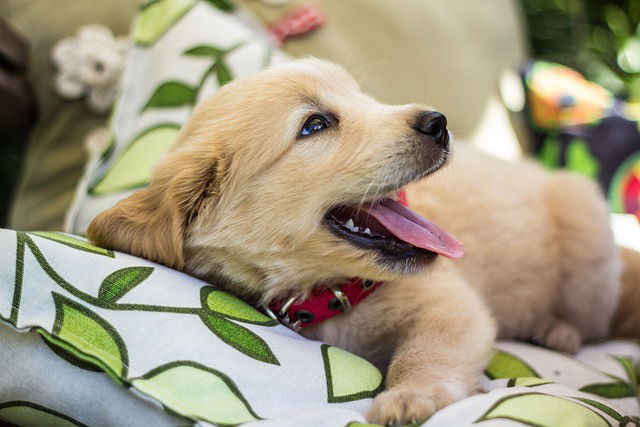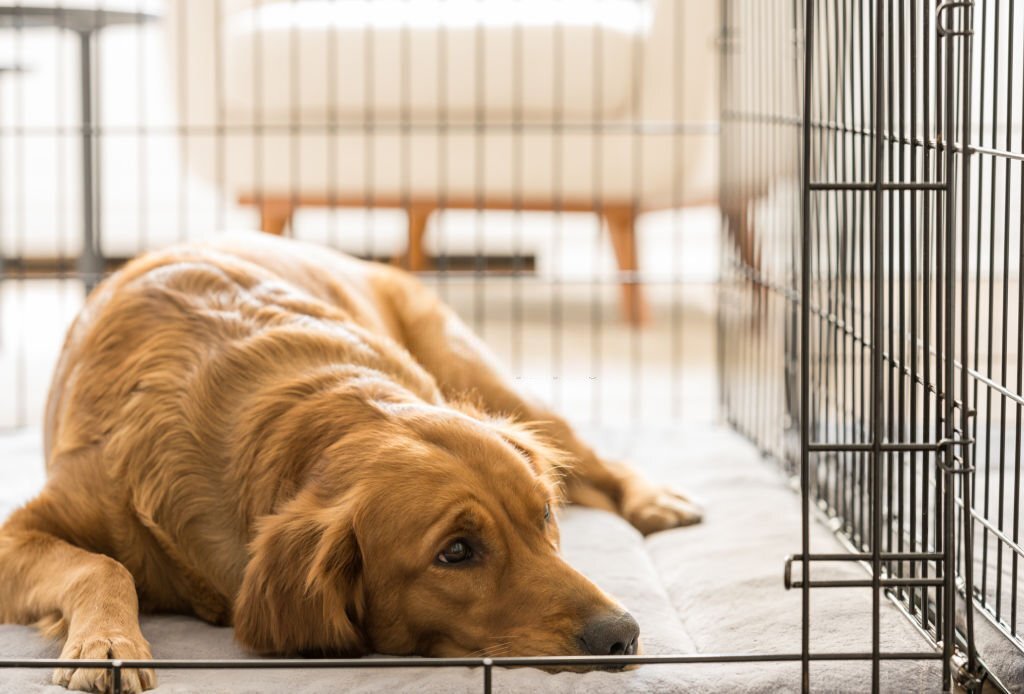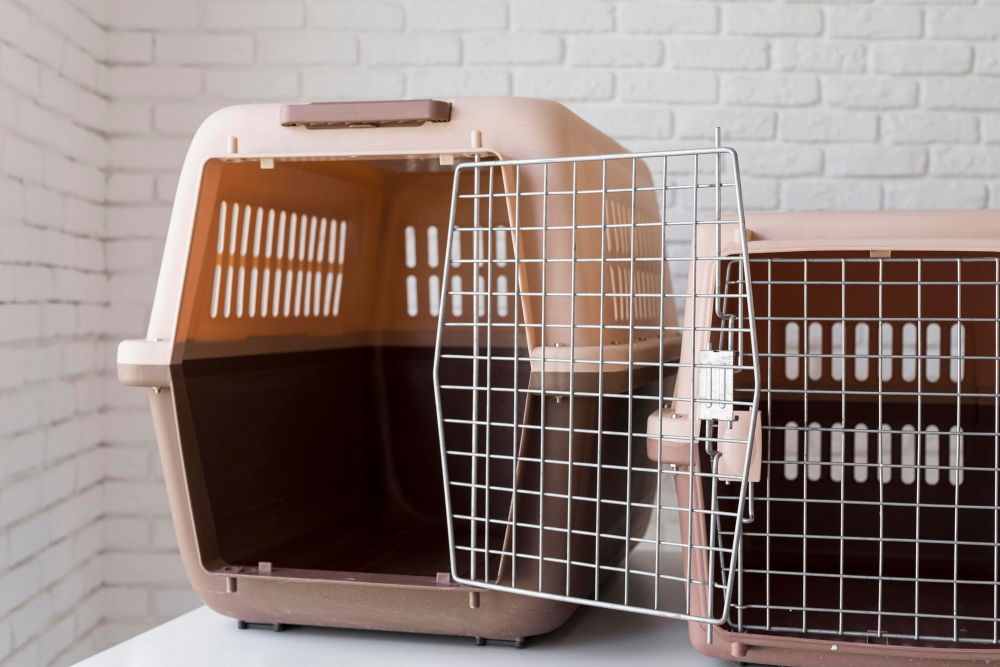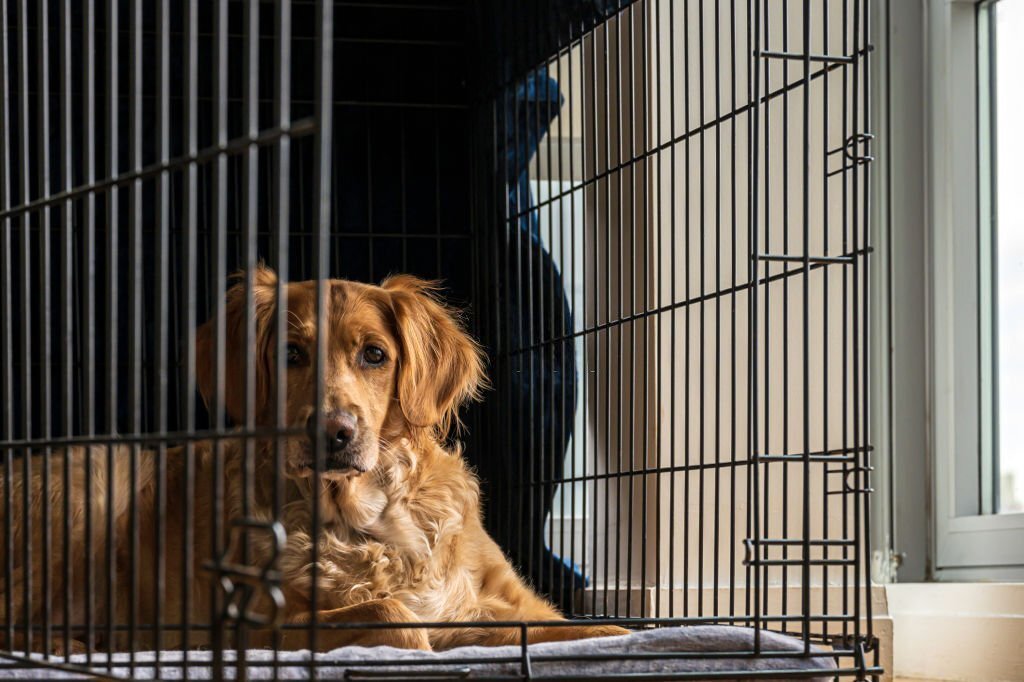We're an affiliate
We hope you love the products we recommend! Just so you know, we may collect a share of sales or other compensation from the links on this page at no additional cost to you. Thank you if you use our links, we really appreciate it!
Golden Retriever owners can attest to the energetic and fun-loving nature of these wonderful family dogs.
You, therefore, need to get a comfy place for your Golden to retreat after a long day of indoor and outdoor activities.
So, what size crate is the best for Golden Retrievers?
Canine behaviorists always recommend getting the right-sized crate for training your dog, otherwise, you may end up confusing the pup with a bigger or smaller one.
Keep reading this post to discover the recommended crate size for both Golden Retriever adults and puppies.
Watch out for our section on the types of crates available and a practical guide on how you can crate-train your fluffy Golden pal.
4 Factors to Consider When Selecting a Crate Size for Your Golden Retriever
1. The Age of Your Dog
How old is your Golden Retriever? Perhaps this should be one of the first questions you need to ask yourself when scouting for a crate.
If you have a younger Goldie, you can opt for a crate with a divider. This will allow you to modify the size to suit your pup as they grow.

But if you have an adult Goldie, you can choose a fixed-size crate based on your dog’s measurements and other considerations.
2. Your Dog’s Weight
You should also consider the weight of your Golden Retriever when purchasing a pet carrier for road trips or air travel.
An adult Goldie with the ideal weight should work from a sizeable crate that can support their size.
But if you have a younger dog with minimal weight, you may opt for an appropriate plastic crate for their training.
3. The Height of your Dog
When choosing a crate for your Golden, you need to consider one that provides them enough headroom to get and stay comfortably.
You wouldn’t want a situation where your furry friend hits their head on the crate’s door and gets cramped while inside.
4. Your Dog’s Length
You also need a crate that corresponds to your Golden’s body length, from head to tail.
A right-sized crate should allow your pup to get in with ease and make a few turns while inside without hitting the walls.
How To Measure a Golden Retriever for A Crate
For this procedure, you will need a tape measure and a flat surface – preferably inside your house.
We recommend petting your dog before taking the measurements to keep them calm and relaxed.
Measuring your Golden Retriever’s Height
Ask your Golden Retriever to sit on a flat surface with their head tilted upwards a little bit. Take a tape measure and measure the height from the front paws to the top of the head.
Add 4 inches to the measurements obtained. This will give your Goldie enough room to sit without hitting their head on the crate’s ceiling.
Measuring your Golden Retriever’s Height
Ask your lovely Goldie to stand and remain calm on a flat surface. Use a tape measure to take the reading from the base of their tail to the tip of the nose.
Add 4 inches to the measurements obtained, and that would be the desired length of your dog’s crate.
This would allow your dog to enter the crate and make a full turn while inside without hitting the walls.
The height and length of the crate are enough to get the right size for your dog. The width is always made in proportion to the two measurements.
What Size Crate for Golden Retrievers
Most adult Golden Retrievers can do well in 42-inch (XL) crates, but this should not be a universal measurement for all.
This ideal size will provide your furry friend with enough room to have a comfortable stay in the crate without hitting the side walls or the ceiling.

However, some Golden Retriever owners have reported that 36-37” crates have worked well for their dogs at home.
If you have a Golden puppy, we recommend investing in a 42” crate with a divider as well. Golden Retriever puppies can grow really fast, and you wouldn’t want to replace their crate every so often.
A removable panel will allow you to divide the crate into smaller portions that are appropriate for your young Golden.
Types Of Crates for Golden Retrievers
There are different types of crates based on their styling and the material used to make them.
When choosing the best crate for your Golden Retriever, you need to know the specific type that you need.
These are some of the most common types of crates for Golden Retrievers:
1. Wire Crates
Wire crates, also known as metallic dog crates, are the most popular indoor dog houses in many homes.
These crates are made using soft wires and steel frames, and they usually have a plastic tray at the bottom.
The metallic wire construction is perhaps the most preferred because it offers excellent ventilation and visibility.
Wire crates are the best choice for Golden Retriever puppies that chew a lot since they don’t get a soft surface for them to sink their teeth into.
The other good thing about metallic crates is their toughness and overall stability when housing a large dog.
If you have a strong Goldie, you can consider wire crates crafted with heavy-duty steel and metallic framework.
Such cages are nearly impossible to break, and you can be sure to house your dog in a secure place.
Advantages of Wire Crates
- They offer excellent airflow and visibility for your dog.
- The metallic frames are very easy to clean and maintain. Some of these crates have removable plastic trays at the bottom for easier cleaning.
- It’s nearly impossible for dogs to chew or break apart metallic crates.
- Wire crates can be collapsed, folded, and stored in a minimal space when not in use.
- The metallic framework does not absorb dog odor.
Disadvantages of Wire Crates
- Dogs can make lots of noise while moving inside a wire crate.
- The wire crossbars can pick up dog hair.
- The metallic framework can rust over time.
- Some wire crates have poor closure, making it easier for dogs to escape.
2. Plastic Crates
Plastic dog crates are another popular option for pet parents, especially when traveling. Most of these plastic cages have met the standards required for airline approval.
These crates are made using hard plastic, and they typically have wired doors on the sides.
A plastic dog crate is certainly sturdier than a soft-sided crate, and it will also offer a little more privacy for your Golden Retriever than a wired cage.

But even with the holed door in this crate, the airflow isn’t always the best, and the dog cannot stay there for a very long time.
Some plastic crates are easy to clean, while others may require lots of work to maintain, depending on the type of plastic used and furnishing.
Advantages of Plastic Crates
- Those made with thick plastic are very durable and long-lasting.
- They offer a convenient way of traveling with your dog on-air, both in-cabin and below the seat.
- Plastic crates can help to keep reactive dogs secured and quiet since they don’t have a chance to view the outside like a wired crate.
- They provide a perfect den for dogs to get comfortable and cozy in a secure place.
Disadvantages of Plastic Crates
- They offer limited ventilation and visibility, which limits the amount of time you can crate your lovely pup.
- Not good for heavy chewers since they may find it easy to nibble on the side plastic.
- The plastic material can absorb doggie odor, which can leave a permanent smell if not cleaned regularly. This makes them unfavorable for housetraining a puppy.
- Plastic crates are not collapsible or foldable, meaning they can occupy lots of storage space when not in use.
3. Soft-sided Crates
Soft-sided crates, also called fabric dog crates, are made with canvas overlayed on a metal framework or plastic tubes. These fancy-looking crates are lightweight and highly portable.
They are also a very popular option for pet parents because of the convenience and easiness of carrying.
However, they are not the best option for heavy chewers since they can easily tear the fabric apart.
Advantages of Soft-sided Crates
- They are highly portable and suitable for road trips, camping, and short air travel.
- They can be collapsed and folded for easier storage when not in use.
- They are very comfortable for dogs.
- They are less noisy, compared to wire crates, when the dog moves around while inside.
- Fabric dog crates are highly stylish and beautifully designed to fit your personal style or liking.
Disadvantages of Soft-sided Crates
- Soft-sided crates are not favorable for Goldens who like to chew, scratch, or dig in their bedding.
- They are not as long-lasting as the other two types of crates.
- Cleaning a soft-sided pet crate can be difficult and time-consuming. They are therefore not suitable for carrying puppies who have not been potty-trained.
Frequently Asked Questions
1. Do I need to crate train my golden retriever before putting him in a crate?
Yes, you need to crate-train your Golden Retriever first. Crate Training is essential and helps in forming responsible behavior and provides a safe place for your Golden Retriever to retreat and sleep.
2. How long should I crate my golden retriever?
Golden Retriever puppies under 6 months can stay in a comfy crate for up to 3 to 4 hours at a time. These pups cannot hold their bladder for that long, hence they need potty breaks in between.
Adult Golden Retrievers can manage between 6 to 8 hours at a time with intermittent potty breaks.
3. Can I leave my golden retriever in a crate while I am at work?
No! We do not recommend leaving your Golden Retriever in a crate during the day while you go to work.
Doing this could lead to serious emotional issues, including stress, anxiety, and depression.
Make sure your dog is fully potty-trained so that you can leave them free in the house without worrying about accidents.
If your work schedule runs into long hours, we recommend hiring a pet sitter or taking your dog to daycare to get human interaction and stimulation.
4. What type of crate is best for a Golden Retriever?
Wire crates are definitely good and versatile for Golden Retrievers. They offer excellent ventilation and visibility, and they are constructed with strong metals to withstand the high energy levels of Golden Retrievers.
If you are on a journey, then a plastic crate will serve you better with your Golden than a soft-sided one.
5. At what age can I stop crating my Golden Retriever?
On average, you can stop crating your fully trained Golden Retriever when they are 2 years old or above.
At this age, the trained Goldie would have fully matured and would certainly be more responsible when left freely in the house.
Be careful when withdrawing a crate from your dog. You should do it slowly while redirecting the dog to other safe places to retreat.
Final Thoughts
A common mistake that most people make when buying a crate for their Golden Retriever is to think that ‘the biggest one is the safest’.
A bigger crate will not offer your Goldie the ideal space and privacy needed to get the den-like feeling that they look for.
Moreover, most dogs cannot associate with a wrong-sized crate. They need something that corresponds to their body size.
42” crates are ideal for adult Golden Retrievers to make them feel safe and comfortable. And even if you have a puppy, we still recommend going with this size option and a divider.
Laura is the founder of Furs'n'Paws. She is a also a pet writer and expert with more than 20 years of experience of working with dogs and cats. She developed a very strong love for animals at a young age. Her passion led her to establish a thriving pet sitting and dog walking business in Dubai. As an expert in pet training, behavior, and nutrition, Laura is committed to helping pet owners and pet lovers by offering high-quality information on a wide range of topics.



No responses yet